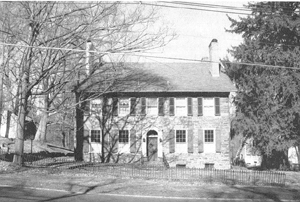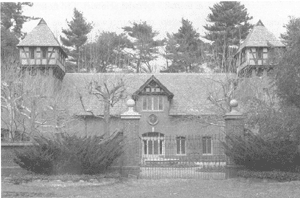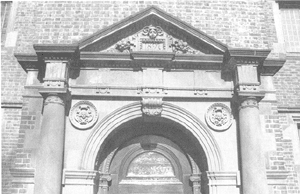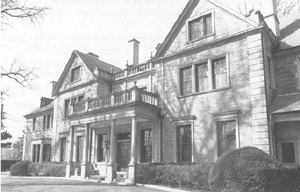|
Historic Preservation in Princeton Township
Historic Districts and Sites
Designated by Princeton Township |
The Princeton Township Historic Preservation ordinance was adopted in 1987 with fourteen districts and several buffer zones. A buffer zone is a zone located adjacent to a district. Preservation plans must be approved for work proposed in both historic districts and buffer zones. The ordinance outlines regulations for proposed development in these areas. In 1992 a 15th district was designated - the Donald G. Herring Estate-Old Arreton Road district.
1. Maybury Hill (c. 1725) - Snowden Lane
Maybury Hill was designated a National Historic Landmark in 1971. Joseph Hewes, a signer of the Declaration of Independence for North Carolina, was born here. Maybury Hill was built in two stages, the first before the middle of the 18th century; the expansion, producing a five-bay facade, was probably carried out in 1768. It has had other changes through the centuries, the most recent in 1993-94 when the building was restored and a frame wing was added to the north side.
2. Kingston Mill Historic District - Settled in 1683 A rural/industrial early settlement area in Central New Jersey centered on a grist mill located on the Millstone River (now part of Lake Carnegie). This district includes the Gulick Farm and several 18th century buildings. The boundaries of the local district coincide with those of the National Register District. This district has a historic district buffer zone area.
3. Tusculum (c. 1773) - Cherry Hill Road
Tusculum was the summer home and farm of John Witherspoon, a signer of the Declaration of Independence and President of the College of New Jersey (now Princeton University). Although its property boundaries do not coincide with those prevailing in Witherspoon's day, they do retain a sense of the agricultural open space that surrounded the house originally. The National Register boundaries are confined to 20 acres surrounding the house. The barn is one of the best examples of early 18th century barns in New Jersey. This district has two buffer zones.

Breuer Hill - built c. 1800
Princeton Battlefield-Stony Brook Settlement Historic District
4. Princeton Battlefield-Stony Brook Settlement Historic District Settled c. 1686-1777
The largest district in the Township, this district was placed on the National Register in 1966, and enlarged in 1972 and in 1989. It contains the site of the Battle of Princeton and includes Battlefield Park and the Stony Brook bridge on Route 206 which are National Historic Landmarks. In 1989 the district was enlarged to encompass the area of Stony Brook settlement established by the first Quakers in the community. These boundaries coincide with the National Registers boundaries. This district has two large buffer zones.
5. Mansgrove (c. 1725) - Terhune Road
John N. Simpson built the main block of this house c. 1800. It consists of a 2 1/2 story, five bay center hall structure, with two internal chimneys and fine Federal detailing, attached to a lower 2 story, 3 bay wing which may have been built as early as the mid eighteenth century. Mansgrove has strong associations with one of Princeton's pioneering landowners, Judge Thomas Leonard.
6. Castle Howard (c. 1760) - Castle Howard Court
This building, c. 1760, was probably constructed by Richard Stockton, uncle of the signer. Like many early houses in central New Jersey, this still survives in plan as revealed in the cellar, but the present appearance of the facade is the result of mid-19th century alterations. There have been many prominent owners which have included members of the Stockton family, John Witherspoon, and Captain Howard, a British military officer.
7. Drumthwacket - c. 1835
This building on Route 206 is owned by the State of New Jersey and is the official residence of the Governor. The center block is the original Greek Revival mansion of Charles Smith Olden, who served as Governor during the Civil War. The wings were added by Moses Taylor Pyne. This estate, under Pyne's direction, became a development of extensive landscaping and a model farm with the guidance of his architect Raleigh C. Gildersleeve. This district includes the mansion, Greek Revival c. 1835 with Colonial Revival flanking wings added between 1893 and 1901 by Pyne, and the Butler's house, also Greek Revival. Adjacent to this lot is the one story farm house of Thomas Olden, circa mid-18th century, from which its occupants watched the Battle of Princeton. This house has been moved three hundred yards to the north from its original site and lies presently near Route 206.

Drumthwacket Dairy - built c. 1899
8. Drumthwacket Outbuildings
The estate's six outbuildings, which lie on their own lots outside the Drumthwacket lot, are designated locally as individual sites. These outbuildings reflect the interest in Tudor Revival rather than Greek Revival. The Coach House/Stables are Shingle style.
a. Coach House/Stables' c. 1896
b. Greenhouse Potting Shed c. 1899
c. Garden Building c. 1899
d. Gardener's House c. 1899
e. Farmer's House and Dairy c. 1899
f. Cow Barn c. 1899
9. Princeton Basin - Settled 1834
This district was significant in regional transportation and commerce from 1834 until 1932. Located along the banks of the Delaware and Raritan Canal, the area quickly developed as a small industrial and shopping center on both sides of the canal in Princeton and West Windsor Townships. Seven nineteenth century frame structures survive on the north and west sides of Basin Street. This local district also has a buffer zone and is only locally designated.
10. Delaware and Raritan Canal Historic District - c. 1832
A park along the 1832 canal, it is owned by the State of New Jersey and presently serves as a mostly passive recreation park. The canal was entered on the National Register of Historic Places in 1973 and it serves many communities in central New Jersey.
11. Joline-Gulick House (c. 1830-1857) - Princeton-Kingston Road
This house consisted originally of one structure, a Greek Revival house with a Victorian Wing. The two houses were separated and the Victorian wing was placed on the adjacent lot to the north. The older, main portion is one of the best examples of a vernacular Greek Revival domestic building. Its addition is a distinctly Victorian house, rare in Princeton Township.
Princeton Township - Historic Sites & Districts

Constitution Hill - 1897
12. Constitution Hill (c. 1896-97) - Constitution Hill East
Constitution Hill is an outstanding example of the work of the Philadelphia firm of Cope & Stewardson in the Tudor Revival Style. This district consists of the mansion and the stables/coach house. The house was converted to a condominium with its detailing preserved. Although modern houses surround the house, the original complex of the two original buildings retains the ambiance of Princeton's turn of the century estates.
13. Edgerstoune (1903) - Winant Road
This house, built for Archibald D. Russell and designed by William Russell of the firm Clinton and Russell of New York City, was the centerpiece of a 273.7 acre estate. It is a good example of the English Tudor Revival. It now serves as the administration building of the Hun School.
14. Olden Manor (c. 1720) - Olden Lane
This site was owned by the Oldens, one of Princeton's pioneering families, from the 1690's to the 1920's. The house has the appearance of a prosperous farm house incorporating a small 18th century dwelling in its west wing. It has served as the residence of the director of the Institute for Advanced Study; its most famous resident has been Robert Oppenheimer.
15. Donald G. Herring Estate-Old Arreton Road - c.1919
The district contains the surviving remains of an estate complex called "Rothers Barrows" designed by Wilson Eyre for Herring, built in 1919. This estate is on the National Register. Additionally, included in the local district are two buildings which comprised part of the original Princeton Hospital buildings. These buildings were moved to Arreton Road in 1952.
Additional National Register Districts
Two National Register Districts are not locally designated:
The Mountain Avenue Historic District is on the north side of Mountain Avenue between the west side of the Mountain Lakes Preserve and Quarry Lane. It forms a unique enclave of middle-class suburban development of the late 19th and early 20th centuries and is associated with the shift of a long-established local family from agriculture to other pursuits.
The Lake Carnegie Historic District includes the first artificially made lake in the United States, created for crew racing. Since its construction in 1905-06, it has been the site of Olympic trails in 1936 and 1948, and several national major intercollegiate rowing events.

Edgerstone - built 1903